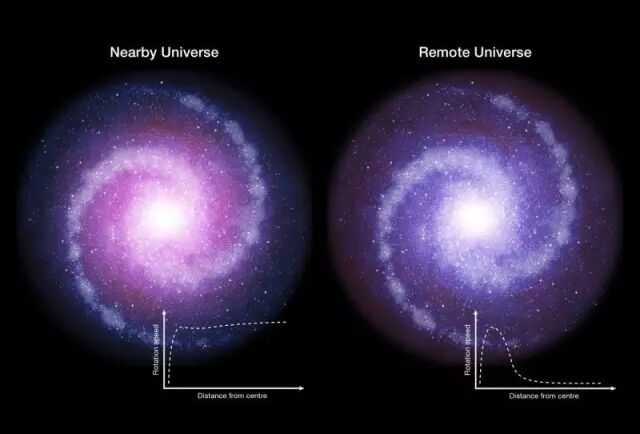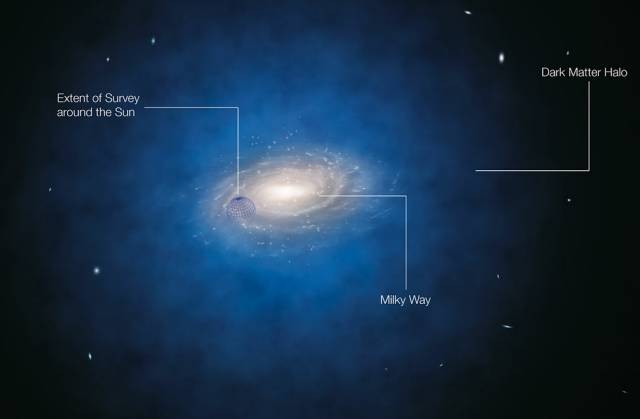本文经授权转载自公众号“原理”(ID:principia1687)。
在约 100 亿年前宇宙迎来了一次诞生星系的高峰,科学家刚刚发现那时的大型产星星系主要是由重子或“普通”物质组成的。这跟现代的星系截然不同,因为现代的星系深受暗物质的影响。欧洲南方天文台的甚大望远镜对宇宙早期的六个大型产星星系进行观测得出了这一意外的结果:暗物质在早期宇宙的影响力没有现在重要。

左侧是离我们较近的现代星系,右侧是离我们较远的远古星系。最新研究表明,暗物质(红色区域)对在早期形成的大质量产星星系盘有较少的影响。因此,远古星系的外围区域旋转的比现代星系要比慢的多。(图片来源:ESO/L. Calçada)
我们看到的闪闪发亮的恒星,发光的气体和尘埃云都是由普通物质组成的。但是暗物质却不辐射、吸收或反射光,只能通过引力的效应来观测它的存在。如果只有可见的普通物质存在于星系之中,那么就无法维持星系的高速自转,星系就会分崩离析。但事实却并非如此,因此天文学家断定有一种不可见的暗物质存在,提供着额外的引力维持着整个星系。
这项最新结果是由德国普朗克地外物理研究所的 Reinhard Genzel 所领导一个国际天文科研团队得出的。他们发现,不像现代的螺旋星系,这些远古星系的外围区域自转的速度比其星系中心部分的要慢的多,意味着暗物质的总量要比预计的少很多。

星系自转曲线:以恒星或气体的轨道速度为 y 轴,相对于至星系中心距离为 x 轴的图。左侧是离我们距离较近的现代星系,我们看到星系的自转曲线趋于平稳,代表存在大量暗物质。右侧是离我们非常遥远的远古星系,星系自转曲线在外围区域发生了显著的下跌,证明只有少数的暗物质。(图片来源:ESO)
从上图中我们可以看到,这些远古的星系的自转速度随着离星系中心的距离的增加发生了明显的下跌。之所以会这样有两种可能:一是大部分这些早期的大型星系主要由普通物质主导,它们包含的暗物质总量比现代星系中的要少的多;二是这些远古星系的星系盘要比现代螺旋星系更加的动荡。
这两种现象在宇宙越早期就越显著。这意味着在宇宙大爆炸后大约 30 至 40 亿年间,星系中的气体已经能够有效地凝聚成一个扁平的自转圆盘,而包裹着它们的暗物质晕则更大、更松散。只有在经历了更久远的时间后,暗物质才能够凝聚,因此它对星系自转曲线的效应到了今天才变得越来越重要。

暗物质晕(Dark Matter Halo)。(图片来源:ESA)
这个解释跟观测相符意味着早期的星系包含了更多的气体,并且更加的紧凑。
除了对这六个星系的自转曲线进行单独测量,研究人员还把其它的样本(信号较弱的)结合产生一个合成的自转曲线,显示了同样的速度递减趋势。此外,另外两项对240个产星星系的分析也支持了这一结果。
详细的模拟显示,在高红移的星系(那些离我们非常遥远的星系)中,只要普通物质占据星系物质总量的一半以上,就会完全主导星系的动力学。
参考文献 https://phys.org/news/2017-03-dark-influential-galaxies-early-universe.html
注:凯斯西储大学天文系主任 Stacy McGaugh 在博客中对这项工作提出质疑,对细节感兴趣的读者可以通过以下链接阅读(英文,需翻墙)
https://tritonstation.wordpress.com/2017/03/19/declining-rotation-curves-at-high-redshift/
论文基本信息
【标题】Strongly baryon-dominated disk galaxies at the peak of galaxy formation ten billion years ago
【作者】R. Genzel, N. M. Förster Schreiber et al.
【期刊】Nature
【日期】2017.3.16
【DOI】10.1038/nature21685
【摘要】In the cold dark matter cosmology, the baryonic components of galaxies—stars and gas—are thought to be mixed with and embedded in non-baryonic and non-relativistic dark matter, which dominates the total mass of the galaxy and its dark-matter halo. In the local (low-redshift) Universe, the mass of dark matter within a galactic disk increases with disk radius, becoming appreciable and then dominant in the outer, baryonic regions of the disks of star-forming galaxies. This results in rotation velocities of the visible matter within the disk that are constant or increasing with disk radius—a hallmark of the dark-matter model. Comparisons between the dynamical mass, inferred from these velocities in rotational equilibrium, and the sum of the stellar and cold-gas mass at the peak epoch of galaxy formation ten billion years ago, inferred from ancillary data, suggest high baryon fractions in the inner, star-forming regions of the disks. Although this implied baryon fraction may be larger than in the local Universe, the systematic uncertainties (owing to the chosen stellar initial-mass function and the calibration of gas masses) render such comparisons inconclusive in terms of the mass of dark matter. Here we report rotation curves (showing rotation velocity as a function of disk radius) for the outer disks of six massive star-forming galaxies, and find that the rotation velocities are not constant, but decrease with radius. We propose that this trend arises because of a combination of two main factors: first, a large fraction of the massive high-redshift galaxy population was strongly baryon-dominated, with dark matter playing a smaller part than in the local Universe; and second, the large velocity dispersion in high-redshift disks introduces a substantial pressure term that leads to a decrease in rotation velocity with increasing radius. The effect of both factors appears to increase with redshift. Qualitatively, the observations suggest that baryons in the early (high-redshift) Universe efficiently condensed at the centres of dark-matter haloes when gas fractions were high and dark matter was less concentrated.
【链接】 http://www.nature.com/nature/journal/v543/n7645/full/nature21685.html

阅读更多
内容合作请联系
[email protected]















